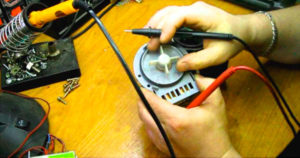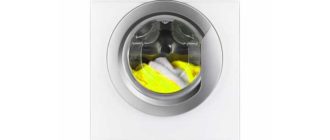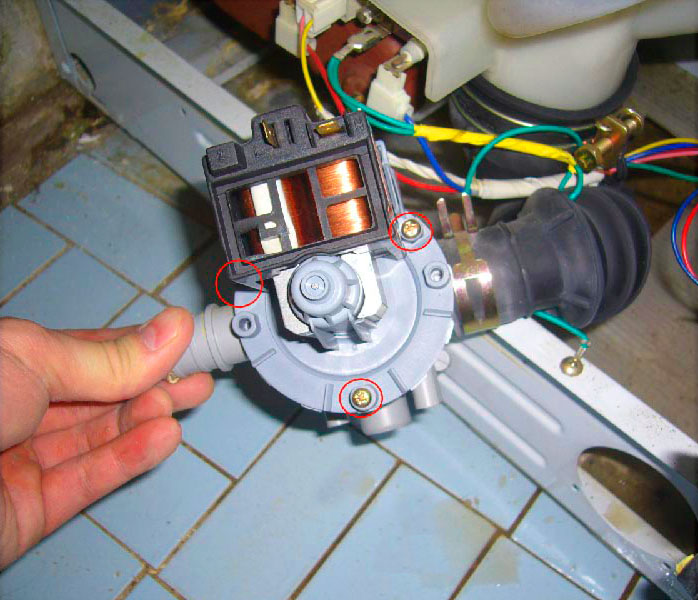 In modern automatic-type washing machine designs, checking the pump is not a difficult task, but not everyone performs it correctly. There were cases when the owners changed the working drain pumps, having spent a lot of time, as well as money, and still the problem did not go away, which hinted at a breakdown of a completely different element of the washing machine.
In modern automatic-type washing machine designs, checking the pump is not a difficult task, but not everyone performs it correctly. There were cases when the owners changed the working drain pumps, having spent a lot of time, as well as money, and still the problem did not go away, which hinted at a breakdown of a completely different element of the washing machine.
We will tell you how to properly check the pump in the washing machine, which will help you to save yourself and your helper from a huge number of various breakages, and learn to find and troubleshooting of such nature.
What do we need to check the pump?
Let us tell in detail about the signs:
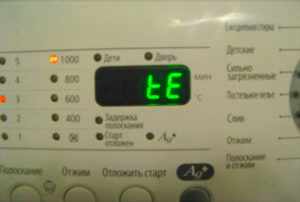 The first sign is error code - it appears because of the results of the self-diagnostic system - such a system is equipped with almost all modern models of the automatic type. If the error code you decoded leads you to the breakdown of the pump, it is better to check first drain pump.
The first sign is error code - it appears because of the results of the self-diagnostic system - such a system is equipped with almost all modern models of the automatic type. If the error code you decoded leads you to the breakdown of the pump, it is better to check first drain pump.- Before starting the process of draining water from the drum, the washing machine stands in place and is in the same position with all the water.
- In the washing design, the drain pump does not reproduce absolutely no sound, or even signs of life.
If you already know for sure or just suspect a possible problem with the pump, then do not put off repairs for later, and it is better to immediately look for the necessary tools for this repair.
Large equipment, as a plumber we do not particularly need, we just need a couple of toolsWhich, in principle, is not difficult to find:
- Screwdrivers (flat and cross);
- Multimeter;
- Pliers;
- Needle (or needle as a last resort).
If you do not have a multimeter, we recommend buying it, because it will be useful in the future, not only for this problem, but in general. This is quite a necessary device in the household for all of us. So, take a working multimeter and go eliminate the problem.
Getting closer to the element
In the washing design of the automatic type there is an opportunity to consider the drain pump, without disassembling the housing.
This possibility is present in many models. To get to the drain pump, it is necessary:
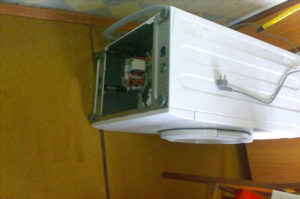 Disconnect the machine from the power and all kinds of communications,
Disconnect the machine from the power and all kinds of communications,- first drain the water through the drain filter we need,
- remove the detergent tray (powder or conditioners, etc.),
- put a cloth under the floor (to insure in case there is water left in the machine).
- To turn the construction on the right side of the body.
In principle, this is great. Good, because there is an opportunity to get to the pump and even to the motor from the bottom, without disassembling the machine, and bad because of the fact that the parts can be damaged when transporting or carrying the washer, or elements can get clogged and eventually break because of dust.
 In this case, you need to look through the bottom of the structure inside the housing, where you will have a view of the pump. The pump is located in front of the drain pump, or to be more precise, in front of its housing. You probably already know what it is about, because you clean the pump in time, unscrewing it beforehand. The pump is also very difficult not to notice.
In this case, you need to look through the bottom of the structure inside the housing, where you will have a view of the pump. The pump is located in front of the drain pump, or to be more precise, in front of its housing. You probably already know what it is about, because you clean the pump in time, unscrewing it beforehand. The pump is also very difficult not to notice.
There is a chance that your particular model of washing machine closes the bottom with a special cover. But difficulties with this as well should not arise, you all in the same order put the washing machine on the right side, take a screwdriver (Phillips) and get rid of the screws that overstay the cover. Once you've unscrewed everything, simply pry the cover off (you can use a flathead screwdriver) and remove it, and you'll have access to the "inside" of your washing machine.
It's a bit more complicated if your washing machine is equipped with a leak-proof: in this case there will be a tray with a special sensor at the bottom, it must also be removed. To achieve the goal, and finally to consider the washing machine drain pump in this situation, we need to act in accordance with all eight steps of this algorithm:
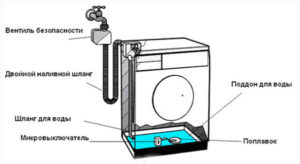 It is necessary to unplug the washing machine, disconnect from the sewer and water;
It is necessary to unplug the washing machine, disconnect from the sewer and water;- Drain all remaining water through the drain filter, or through the emergency hose to drain the water;
- Pull out the washing machine to the middle of the free space, previously laying dry rags on the floor (for insurance);
- Pull out the laundry detergent tray;
- Turn the construction over to the right side of the case;
- We pick up and pull off the tray (it is necessary to pull off 4 latches, for this purpose a screwdriver (flat) will do very well);
- Slightly move the pallet - this is done in order to disconnect the wire that goes to the sensor, attached to the body pan;
- We set the pallet further away, and we can freely dig into the elements of the washing machine through the bottom.
The sensor, which is installed on the tray, is responsible for leaks. For example, water somehow gets into the tray during the washing process, the sensor notices this and shuts off the water, simultaneously stopping the washing process. This is done to eliminate such a problem as "flooding".
Checking the mechanical and electrical parts
Once you have found the drain pump through the bottom of the washing structure, it should be checked immediately.
Basically, the owners when repairing the unit with their own hands make one of the most basic mistakes of beginners - they instantly try to check the drain pump with a multimeter, imagining that the matter is in the electrical part.
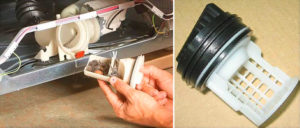 As we know, the drain system of the washing machine is composed so that almost all the debris that enters the laundry tank accidentally ends up in the trash filter. But even the smallest particle of debris that comes into contact with the drain pump impeller can cause you a lot of problems. For example, the same hair: it gets wrapped around the same impeller and thus can stop the operation of the pump. In this case, it is necessary to immediately make a decision and eliminate the problem.
As we know, the drain system of the washing machine is composed so that almost all the debris that enters the laundry tank accidentally ends up in the trash filter. But even the smallest particle of debris that comes into contact with the drain pump impeller can cause you a lot of problems. For example, the same hair: it gets wrapped around the same impeller and thus can stop the operation of the pump. In this case, it is necessary to immediately make a decision and eliminate the problem.
Repair of the pump, as well as its check begins with the removal of this element. The pump is quite easy to remove, here is an order of correct actions:
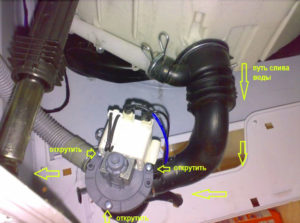 It is best to take a picture of the wiring arrangement;
It is best to take a picture of the wiring arrangement;- Then you can disconnect the wires from the element;
- Unfasten the clamps (use pliers) that hold the hose and spigot on the pump;
- Remove the spigot and hose;
- Take hold of the pump housing, and twist it half a turn against the clock - this way, you will remove the pump.
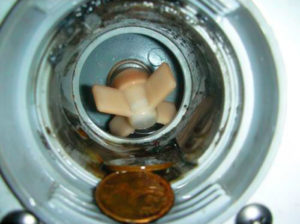 Next, you need to lift the special latches that hold the pump housing, but before this action, it is possible to check the impeller. You will immediately notice if there is something wrong with the impeller, for example, the same coiled hair. When you check the mechanical part of the pump, you need to check the mechanism itself, as well as the rubber gaskets, in addition, you need to clean all the elements of the pump and check for the presence of other residual dirt there. If there is, clean it again.
Next, you need to lift the special latches that hold the pump housing, but before this action, it is possible to check the impeller. You will immediately notice if there is something wrong with the impeller, for example, the same coiled hair. When you check the mechanical part of the pump, you need to check the mechanism itself, as well as the rubber gaskets, in addition, you need to clean all the elements of the pump and check for the presence of other residual dirt there. If there is, clean it again.
If you have done everything correctly, checked the mechanical part of the pump, the pump, and still found nothing, then you can proceed to check the electrical part.
First, set up a multimeter to check the voltage, then connect the device to the pins of the drain pump. If your multimeter screen shows a result of zero or one, then your motor is completely and irrevocably burned out and must be replaced. If the result is in triple digits, you'd better continue looking for the fault, because the motor is completely intact, and it's already clear that it's not the pump. There is a chance that it is the triac of the control board, but we can't say for sure.
[warningBasically, there is nothing complicated about checking the drain pump and the pump in an automatic washing machine, especially if you have previously secured help in the form of instructions from the masters.[/warning
To find, remove and check the pump and drain pump, the machine should not disassemble to a screw, and checking all the elements will also take you a lot of time. Good luck with the repair!

